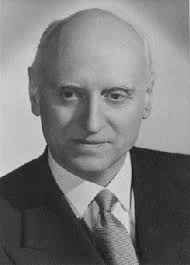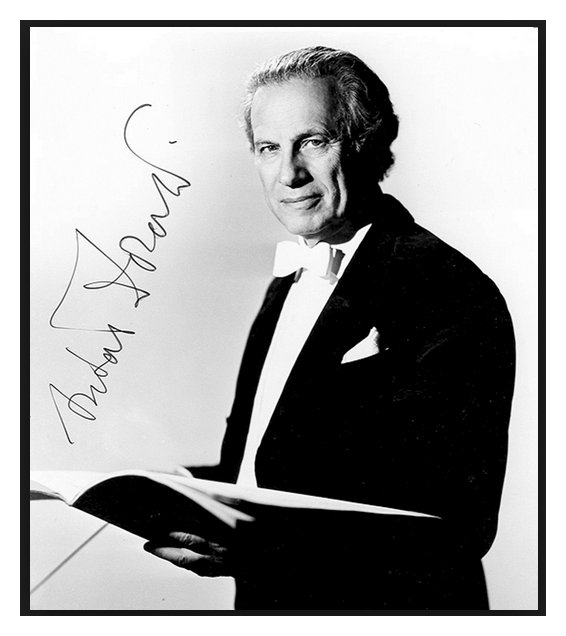This Week in Classical Music: April 11, 2022.Conductors, continued.Last week we started with five famous conductors that were born that week: the Frenchman Pierre Monteux, the German Herbert von Karajan, the British Adrian Boult, the Hungarian-American Antal Doráti, and the Italian Victor de Sabata.We spent much time with de Sabata, following his career till the end of WWII, and we did so because this wonderful conductor isn’t that well known in the US.So, here’s a bit more on Sabata.His previous association with Mussolini didn’t affect Sabata’s international standing, even though in 1950 he was briefly detained in the US under the soon-to-be abolished McCarran Act (his concert at Carnegie Hall ran on schedule and to great acclaim – the recording of the excerpts from Tristan un Isolde which we presented the last week came from that concert).Sabata’s base was La Scala, with which he made several great recordings, including the one from 1953 of Puccini's Tosca with Maria Callas, Giuseppe Di Stefano and Tito Gobbi which many consider the best opera recording of all time.Sabata toured all major European music centers and made recording with the London Philharmonic and the Orchestra of Santa Cecilia, in addition to his own orchestra of La Scala.In 1953 Sabata had a heart attack which forced him into semi-retirement.He died of heart decease in 1967.
Victor de Sabata had a phenomenal ear and musical memory.It’s also said that he could play every instrument in the orchestra.The music magazine, International Record Review, now unfortunately defunct, wrote the following notes about him: “The story is that de Sabata, rehearsing in London around 1930, was asked why he never conducted any English music; because there's nothing worth doing, he answered. Did he know the Enigma Variations? No. So they gave him a score to take home and he went through the work from memory at the next morning's rehearsal, which Elgar himself and Malcolm Sargent attended. De Sabata was apparently correcting mistakes in the parts that neither the composer nor the man who fancied himself its principal interpreter had noticed.”The British music critic Felix Aprahamian recalls the following story (as per Wikipedia): “In the rehearsal interval, he asked theflicorni [the saxhorn, one of the instruments invented by Adolphe Sax] for the final movement to play their brass fanfares. They did. 'What are you playing?' he asked. 'It is an octave higher.' 'Can't be done, Maestro.' ... The Maestro borrowed one of their instruments and blew the correct notes in the right octave.”These is just two of many legendary stories.
Among De Sabata’s recordings is the first ever of Debussy’s Jeux, made in 1947 in Rome with the orchestra of the Academy of Santa Cecilia.Here it is.
Antal Doráti deserves a separate entry (as do Monteux and Boult – we’ve written about Karajan more than once) and we’ll try to do it soon.With Philharmonia Hungarica orchestra Doráti recorded all 104 Haydn symphonies.Here’s no. 100, “Military.”
Victor de Sabata, part II, 2022
This Week in Classical Music: April 11, 2022. Conductors, continued. Last week we started with five famous conductors that were born that week: the Frenchman Pierre Monteux, the German Herbert von Karajan, the British Adrian Boult, the Hungarian-American Antal Doráti, and the Italian Victor de Sabata. We spent much time with de Sabata, following his career till the end of WWII, and we did so because this wonderful conductor isn’t that well known in the US. So, here’s a bit more on Sabata. His previous association with Mussolini didn’t affect Sabata’s international standing, even though in 1950 he was briefly detained in the US under the soon-to-be abolished McCarran Act (his concert at Carnegie Hall ran on schedule and to great acclaim – the recording of the excerpts from Tristan un Isolde which we presented the last week came from that concert). Sabata’s base was La Scala, with which he made several great recordings, including the one from 1953 of Puccini's Tosca with Maria Callas, Giuseppe Di Stefano and Tito Gobbi which many consider the best opera recording of all time. Sabata toured all major European music centers and made recording with the London Philharmonic and the Orchestra of Santa Cecilia, in addition to his own orchestra of La Scala. In 1953 Sabata had a heart attack which forced him into semi-retirement. He died of heart decease in 1967.
German Herbert von Karajan, the British Adrian Boult, the Hungarian-American Antal Doráti, and the Italian Victor de Sabata. We spent much time with de Sabata, following his career till the end of WWII, and we did so because this wonderful conductor isn’t that well known in the US. So, here’s a bit more on Sabata. His previous association with Mussolini didn’t affect Sabata’s international standing, even though in 1950 he was briefly detained in the US under the soon-to-be abolished McCarran Act (his concert at Carnegie Hall ran on schedule and to great acclaim – the recording of the excerpts from Tristan un Isolde which we presented the last week came from that concert). Sabata’s base was La Scala, with which he made several great recordings, including the one from 1953 of Puccini's Tosca with Maria Callas, Giuseppe Di Stefano and Tito Gobbi which many consider the best opera recording of all time. Sabata toured all major European music centers and made recording with the London Philharmonic and the Orchestra of Santa Cecilia, in addition to his own orchestra of La Scala. In 1953 Sabata had a heart attack which forced him into semi-retirement. He died of heart decease in 1967.
Victor de Sabata had a phenomenal ear and musical memory. It’s also said that he could play every instrument in the orchestra. The music magazine, International Record Review, now unfortunately defunct, wrote the following notes about him: “The story is that de Sabata, rehearsing in London around 1930, was asked why he never conducted any English music; because there's nothing worth doing, he answered. Did he know the Enigma Variations? No. So they gave him a score to take home and he went through the work from memory at the next morning's rehearsal, which Elgar himself and Malcolm Sargent attended. De Sabata was apparently correcting mistakes in the parts that neither the composer nor the man who fancied himself its principal interpreter had noticed.” The British music critic Felix Aprahamian recalls the following story (as per Wikipedia): “In the rehearsal interval, he asked the flicorni [the saxhorn, one of the instruments invented by Adolphe Sax] for the final movement to play their brass fanfares. They did. 'What are you playing?' he asked. 'It is an octave higher.' 'Can't be done, Maestro.' ... The Maestro borrowed one of their instruments and blew the correct notes in the right octave.” These is just two of many legendary stories.
Among De Sabata’s recordings is the first ever of Debussy’s Jeux, made in 1947 in Rome with the orchestra of the Academy of Santa Cecilia. Here it is.
orchestra of the Academy of Santa Cecilia. Here it is.
Antal Doráti deserves a separate entry (as do Monteux and Boult – we’ve written about Karajan more than once) and we’ll try to do it soon. With Philharmonia Hungarica orchestra Doráti recorded all 104 Haydn symphonies. Here’s no. 100, “Military.”